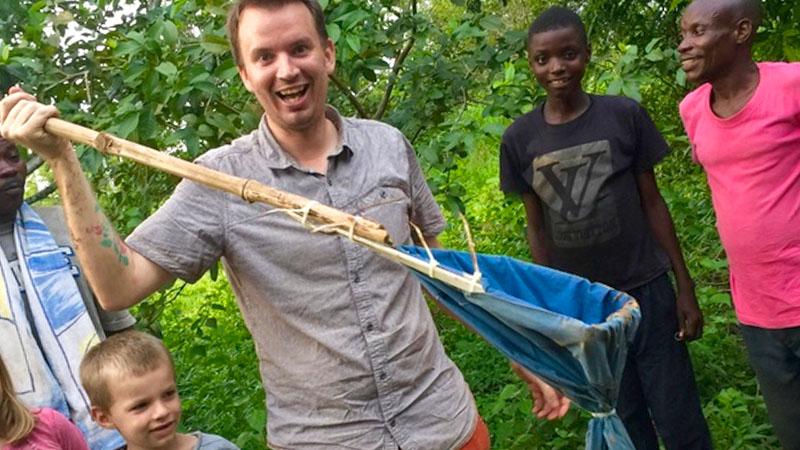
There is a hole in our yard…a deep hole…a deep dark hole. It was dug a little over a month ago and is a future outhouse. As I (Katrina) was unpacking from our trip to Kinshasa, we were summoned over to see a snake that had fallen in. We weren’t surprised to see a stranded animal at the bottom of the hole. So far, it has collected a few lizards, some frogs and lots of crickets. We’ve done our best to lure the lizards and frogs into a bucket and hoist them to freedom. A snake, as we would soon find out, requires more than a simple bucket, especially when you aren’t sure how venomous of a snake you are dealing with.
For most of our congolese neighbors, the only reason to relieve the snake from captivity is for dinner. However, the few who work the closest with us, knew right away we wouldn’t want to hurt it. So, together, we fended off the big sticks and machetes while Kyle thought through how to make a deep-pit snake-catching contraption with items found in our house and Ian ran back and forth to the house fetching the various items.
By this time, a small crowd had gathered around the action, including our kids and some neighbor children. The adults stayed busy helping Kyle and pulling children back from the edge. At one point Tata Luc, our neighbor/gardener/cultural liaison, warned a child, “Don’t fall in because if you do you will die twice.” Kyle immediately laughed. The first death Luc spoke of was the length of the fall, the second was being bitten by the snake.
After about twenty minutes, two curtain rods, a couple long sticks, a bunch of zipties, and a pillowcase had been turned into an adequate contraption, the snake was safely and securely escorted out of the hole.
During all of the commotion, much conversation was had regarding what should happen to the snake. We talked about the local ecology and how snakes contribute. Our neighbors spoke of the danger snakes present to the community. We mentioned that most snakes are not particularly dangerous unless imminently threatened and cornered. Many of our neighbors couldn’t remember the last time someone was actually hurt by a snake, so they communicated the void in their stomachs. This is one place where our cultures and life circumstances collide.
We grew up with grocery stores, full stomachs and plenty of free time to explore and appreciate God’s beautiful and bountiful creation. We know that no resource is infinite. We have read books and taken classes concerning the proper management of resources and lamented our own overconsumption while remaining far removed from our food production. Our neighbors, on the other hand, have grown up working in their family’s fields, which produce their family’s daily meals. They have built homes from natural resources gather themselves, hauled drinking water daily and sometimes gone without full stomachs. I can hear the cries of western conservationists denouncing the practices of rural people groups in developing countries, but there isn’t a perfect answer. Different cultures around the world eat different types of wild and farmed animals and utilize different systems (or none at all) of managing their populations. Some of these systems take into account the longterm effects on the ecosystem and others do not. There is no simple answer to feeding the world without drastically changing cultural norms.
If we were living in the States, we would advocate for changing cultural norms that do not promote global sustainability, starting with our own shortcomings. It gets more complicated when we step outside of our passport country because we don’t always have a clear picture of culture.
We desire to work together with our neighbors toward common goals and it is complicated when our neighbors sometimes struggle to put food on their tables. When it is hard to feed your family, that easily becomes your one and only goal. Given this reality, it is foremost on our hearts to utilize the resources we have available in order to facilitate the alleviation of some of the immediate needs. This is no easy endeavor cross-culturally and we have a long road ahead of us in cultural and language understanding before we can hope to make a positive difference in the daily lives of our neighbors. But we have begun to think outside the box. There are many animals here that provide good food, but left unmanaged are being wiped out.
Kyle brought some native turtles back from Kinshasa to begin to replenish the once abundant number in the Wamba river. Perhaps by farming them we can manage numbers and release a steady supply in to the wild for reproduction and hunting. We are seeking funding to start a crocodile farm and aquaponics project to better raise fish and vegetables alike. We are also researching ostriches.
With each of these potential projects, having to bring all supplies in by plane or truck means the process is slow and expensive. If these are projects that you find interesting please write to tell us, share your knowledge or maybe ask a further question.
Aside from the question of resources, the main question we always come back to is how will these new ideas be received in our community. Will there be enough interest and benefit to the community for these projects to continue longterm?